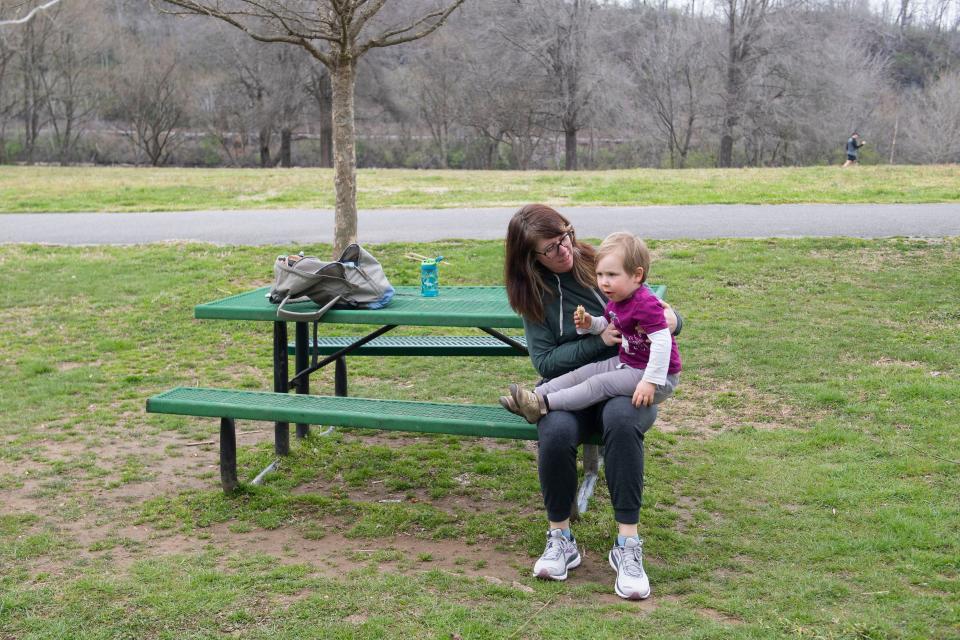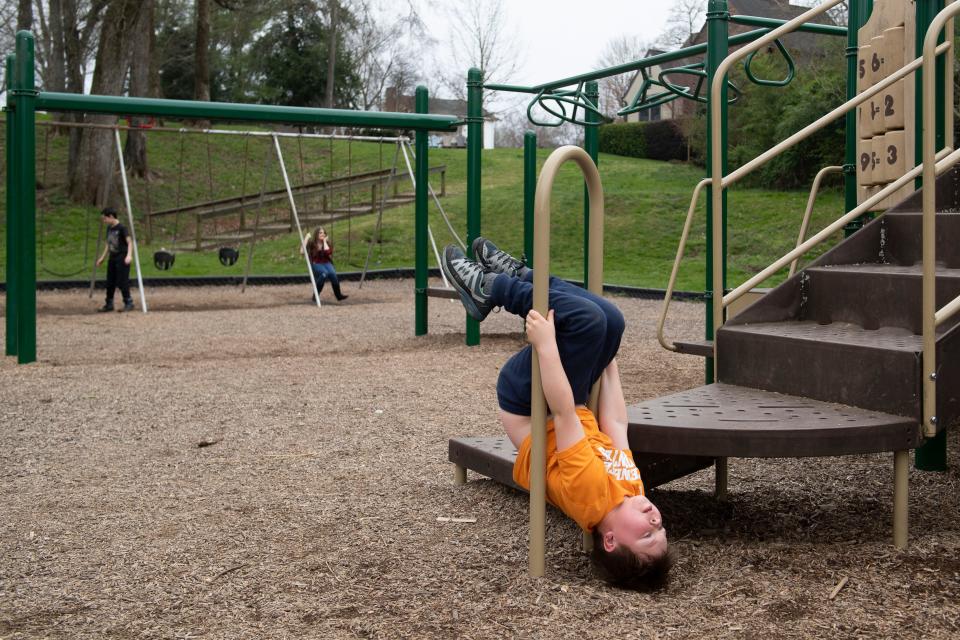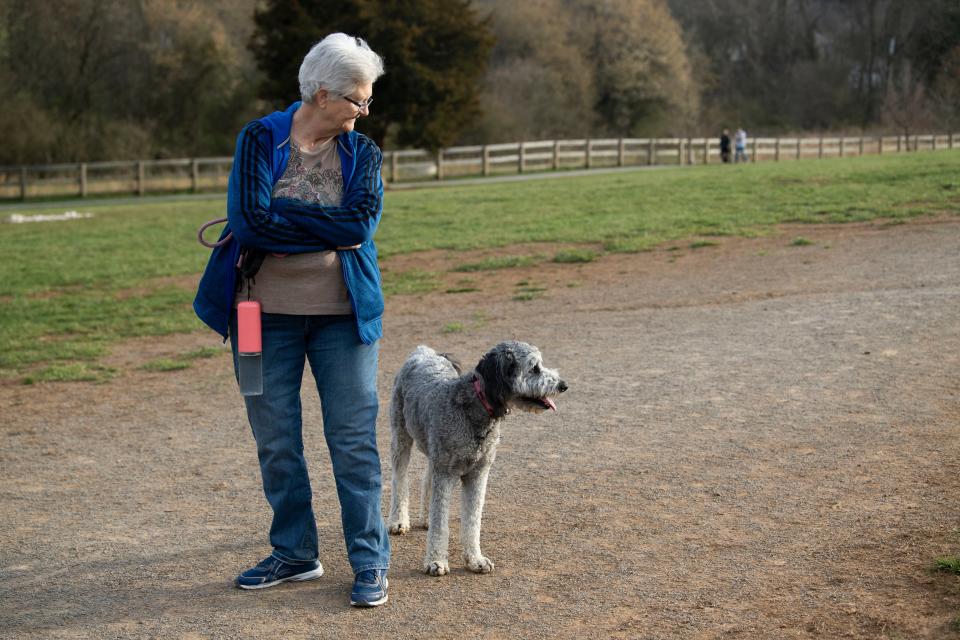Do Knoxville residents have enough access to equitable and updated city parks?
When Carrie Savage looks out her window, she can see moms pushing kids in strollers and families playing on tennis courts. She only has to cross the street to take advantage of the walking trails at Island Home Park.
The proximity to one of Knoxville's 96 city parks places Savage among the 51% of Knoxvillians who live within a 10-minute walk of a public park. That metric measures access, or how "public" a city's parks are and how fairly they're distributed across a city.
For access, Knoxville surpasses Nashville, Memphis and Chattanooga, according to a study by The Trust for Public Land.
Those with the easiest access to parks can reap those benefits the most, even shrinking gaps in equity across race and class. Access to parks boosts social ties, improves physical health and reduces costs both for cities and their residents.
EDUCATORS: Knoxville teacher and basketball coach dies suddenly
DOWNTOWN BRIDGE : UT's proposed bridge could spur housing, retail developments
Knoxville's leaders have been purposeful over decades in creating and distributing parks, and greenways play a big role.
More than 63% of Knoxville's Black residents are within a 10-minute walk to a park, higher than the city-wide average. Just under 50% of Knoxville's Hispanic residents are within that 10-minute radius.
When parks are within walking distance, residents are more likely to make them a part of their daily routine. When more people have access to a park, communities are physically and socially healthier, experts say.
But is access to Knoxville parks equitable?

Knoxville has more than 2,330 acres of parks, including 65 ballfields and 62 playgrounds. It also leads Tennessee in terms of access for communities of color, said Noel Durant, Tennessee state director for Trust for Public Land.
Across income levels, 58% of low-income families are within a 10-minute walk of a park, which is higher than high-income families, according to the study.
"It's incredibly important, especially in neighborhoods who have lacked civic investment for a long time or felt like they're on the outside of economic redevelopment" to have their story reflected in a public place, Durant said.
Knoxville also outranks Nashville and Memphis for equitable access.
How are parks and equity connected?

With all the health and community benefits of local parks, disparities in access are an equity concern. Durant said national trends show residents of color have "on average 44% less park acreage than predominantly white neighborhoods."
Low-income neighborhoods have a similar inequity, Durant said, and these disparities reveal cultural beliefs about who gets to benefit from public spaces.
The quality of a neighborhood's public space can even dictate how that neighborhood bears the effects of weather and climate change.
"Many neighborhoods that are historically communities of color or lower income lack the same tree canopy cover that exists in wealthier neighborhoods, and that has a very significant impact on on a community's perception of the outdoors," Durant said.
Fewer trees means higher temperatures, which leads to higher cooling bills and a decreased ability to regulate temperature. Being surrounded by asphalt and concrete can also affect things like mental health and the market value of homes.
In the case of park access, lower-income communities might have fewer park acres and a higher number of residents per acre as compared to wealthier neighborhoods, Durant said.
What makes Knoxville's parks accessible for Tennessee?

Capital investment in Knoxville's urban trail connectivity — an effort to link parks via greenways and trails — has helped the city's access to parks.
Building connections from downtown to greenways and trails has helped Knoxville attract an outdoors visitor base, said Sheryl Ely, Knoxville's director of parks and recreation.
In its analysis of city park systems, the Trust for Public Land identified five Knoxville neighborhoods in need of a new park: Inskip, Piney Grove, Westborough, Timbercrest and Greenwood Heights.
Ely said the parks department is planning to connect those areas to existing parks by expanding greenways.
Accessible, equitable and quality parks can also attract residents. Though Savage was surprised to learn Knoxville's parks are the best in Tennessee, the ranking made sense in retrospect.
"The Urban Wilderness and things like that, that was a huge draw for us to want to move here," Savage said. "Just to be able to so quickly be on the greenway — that was I would say the deciding factor for me wanting to buy my house."
Durant said a high-quality park should have things like a shade structure, playground and free space. But most importantly, the park should be designed for people to move through it.
"It's not just you're plopped out in a large open lawn ... but a level of intention taken with the space so that when you arrive, you feel like you're welcome there," Durant said. "It's a place where you're supposed to be and you're clued in to how that space is designed for your benefit."
What do parks do for communities?

Being within walking distance of a park has tangible and intangible benefits.
"People who live closer to a park are more active, more physically active and have lower rates of comorbidities," Durant said.
Bonnie Oberhaus visits a park every day if the weather is nice. Along with her dog, Maddie, she finds community in the dog park at Plumb Creek Park in Karns.
"It's funny because I get to know the people by their dogs' names," Oberhaus said. She often sees people she knows in the park. It's a great place for making connections.
Parks are also crucial for weathering the effects of climate change in cities. Greenery helps reduce temperatures and can lower energy costs.
Parks mitigate flooding and stormwater issues by absorbing overflow. They also contribute to a shared sense of investment in a community.
"When you get outside and get to know your neighbor through enjoying a shared enjoyment of your local park, that strengthens a community," Durant said.
This article originally appeared on Knoxville News Sentinel: More than half of Knoxville's residents can walk to a city park

